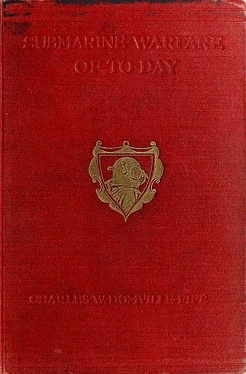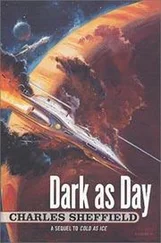Should this manœuvre have placed the surface ship in close proximity to the submarine, one or more depth charges were released, and if the explosion of these damaged the comparatively delicate hull or machinery of the under-water craft, she had either to rise to the surface and fight for her life with her two powerful deck guns, or, if badly damaged, sink helplessly to the bottom, emitting oil in large quantities from her crushed tanks.
Before entering upon a description of the depth charge, however, there is more to say of the hydrophone, which has played such an important part in the defeat of the U-boats.
When the advantages of this instrument had been fully demonstrated in the stern trial of war, successful efforts were made to improve upon the original crude appliances. The “water noises” were reduced and, greatest improvement of all, the hydrophone was made “directional.” By this is meant that when a sound was heard its approximate direction north, south, east or west of the listening ship could be more or less accurately determined. What this improvement meant to a vessel hunting a submarine in a vast stretch of sea will be easily realised. When the sound came up the wires from the submerged microphone the operator had simply to turn a small handle in order to determine from which direction the noise was coming.
If, for example, the sound was first heard away to the east, the instrument was turned to another quarter of the compass. Then, if the noise was plainer, the instrument was turned again until the sound decreased in intensity. In this way the line of maximum sound was obtained, and this showed the direction from the listening ship in which the U-boat was operating.

Fig. 8.—Plan showing how microphones or ears B are fitted in a submarine A to enable it to detect the approach of surface craft.
With the perfection of this invention the hydrophone section of the naval service came into being. Special courses in the detection of submarine sounds were instituted for officers and also for seamen listeners. The actual movements of a submarine under water at varying distances from a hydrophone were recorded by a phonograph, and records made so that the sounds might be reproduced at will for the education of the ear. Surgeons with aural experience estimated the physical efficiency in this respect of would-be volunteers for the hydrophone-listening service, and vessels were formed into special hydrophone flotillas, whose duties consisted of listening in long lines for submarines and when a discovery was made attacking them in the most approved tactical formation, with the aid of depth charges and guns.
A considerable measure of success attended these arrangements, and the author spent many cold hours listening at night for the sound of the wily submarine. On more than one occasion an exciting chase resulted.
It must, however, be pointed out that there is one great drawback to the successful use of the hydrophone. It exists in the necessity for the listening ship to stop before the hydrophone is hoisted outboard, it being quite impossible to hear anything beyond the roar of the engines of the carrying ship so long as they are in motion. Furthermore, all progress through the water must have ceased and the listening ship have become stationary before artificial sounds, such as the propellers of a submarine, can be distinguished from the natural noises of the sea water.
Now it will at once be apparent that not only does a stationary ship offer a splendid target for under-water attack, but also it allows a somewhat humorous game of hide-and-seek to be played between a hunting vessel and a hunted submarine.
Nearly all U-boats were fitted with a number of hydrophones and therefore were as well able to receive timely warning of an approaching surface ship as the surface ship was of the presence of the submarine. But the surface ship had the advantage of speed.
The result of all this was that when a German submarine heard a surface vessel approaching she dived to the bottom, if the water was not too deep or the sea-bed too rocky. Then shutting off her engines she listened. The surface ship, mystified by the sudden cessation of the noise she had been pursuing, also waited, and this stagnation sometimes lasted for hours. Then if the surface ship moved, as she was often compelled to do in order to avoid drifting with the tide away from the locality, the submarine moved also, and the one that stopped her engines first detected the other, but could not catch up to her again without deafening her own listening appliance. In which case the next move would probably be in favour of her opponent.
All of this is, perhaps, a little complicated, but a moment’s pause for reflection will make this curious situation clear to the reader. And so the game went on, with decisive advantage to neither the surface ship nor the submarine. Darkness usually intervened and put an end to further manœuvring, frequently allowing the submarine to escape.
A case of this kind occurred to a vessel, of a certain hydrophone flotilla, commanded by the author. For over four hours the U-boat eluded the pursuing surface ships by moving only when they moved and stopping when they too had stopped, darkness and a rising sea eventually favouring the escape of the submarine, which, a few hours later, was able to attack (unsuccessfully) a big surface ship less than thirty miles distant from the scene.
Nevertheless the hydrophone is a submarine instrument with a brilliant future. It has already been improved out of all resemblance to its original self, and more will undoubtedly follow. It is, however, purely an appliance for the detection of submarines when cruising beneath the surface, and not a weapon for their destruction. It should also be remembered that any improvement made in the efficiency of the hydrophone will benefit not only the surface ship, but also the submarine, for it cannot be supposed that under-water craft will be left without these wonderful submarine ears when their surface destroyers are equipped with them.
The alliance between the hydrophone and the depth charge is a natural one. The former instrument enables the surface ship to discover, first, the presence of a submarine in the vicinity, and, secondly, its approximate position. At this point its utility temporarily ceases and that of the depth charge begins. When a surface ship is hot on the track of a moving submarine she endeavours to attain a position directly over the top of her quarry, or even a little ahead, and then releases one or more depth charges according to whether the chance of a hit is good or only poor.
From this it will be apparent that whereas the hydrophone is the instrument used for the initial detection of the submarine, and afterwards for enabling the surface ship to get to close quarters with her submerged adversary, it is the depth charge with which the attack is actually made.
This weapon is really a powerful submarine bomb. It consists of several hundred pounds of very high explosive encased in a steel shell, with a special firing device which can quickly be set so that the charge explodes at almost any depth below the surface after being released from the above-water vessel.
The methods in use during the war for its release from the decks of surface ships were very diverse, the most usual being for a number of these weapons to be fitted on slides and held in place by wire slings which could be released by simply pulling out a greased pin or bolt.
When the depth charge rolled off the stern of the surface ship it sank to the “set depth” and then exploded like a submarine mine. The result was a shattering effect exerted through the water for several hundred feet around. If the submarine was close to the explosion her comparatively thin plates were nearly always stove-in. When she was over a hundred feet away, however, the rivets holding her plates together were often loosened, and the resulting leak frequently compelled her to come to the surface, where she could be destroyed by gun-fire.
Читать дальше













